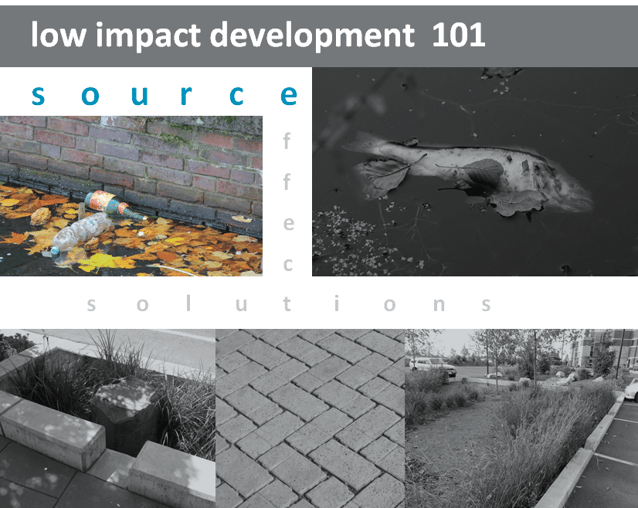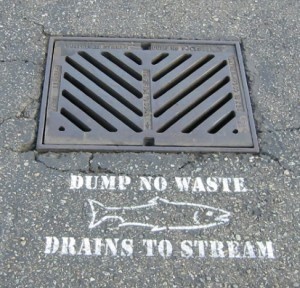
Welcome to Low Impact Development 101! Over the course of this series we will illuminate the primary source and effects of stormwater pollution, and we will conclude by offering some LID solutions to treat polluted runoff. This series is meant for everyone – not just engineers – so please share it in order to help educate as many people as possible about this challenge and how LID measures can be used to address it.
These days, most storm drain catch basins are stenciled with sayings such as “Only Rain in the Drain” or “Dump no Waste - Drains to Stream”. These notices are great ways to raise general awareness about keeping our waterways clean.
 The first thought that jumps to my head when I see one of those stencils is a shady character washing out an empty drum of chemicals or dumping a couple of gallons of used oil straight into the drain. That’s certainly a piece of the problem, but in reality a larger part of the problem features a face that looks a lot more like you and me, living our lives and making some choices that end up having unintended stormwater pollution impacts.
The first thought that jumps to my head when I see one of those stencils is a shady character washing out an empty drum of chemicals or dumping a couple of gallons of used oil straight into the drain. That’s certainly a piece of the problem, but in reality a larger part of the problem features a face that looks a lot more like you and me, living our lives and making some choices that end up having unintended stormwater pollution impacts.
That’s right – the primary source of stormwater pollution is you and me. Don’t believe it? Here are some of the most common ways we pollute:
Automobiles. How many people have a car they park on a drip pan, or out in the street because they don’t want an oil stain on their driveway or garage floor? These few small drips may not seem like a big deal or worth the hassle or expense to fix, but from a big picture pollution perspective, think about those few drips a day, multiplied by the millions of cars that drive all over our roads. That’s a tremendous impact.
Grass Lawns. Having a nicely manicured and lush green lawn is almost as American as the automobile. To attain such a green lawn, many people add chemical fertilizers. The two main ingredients in these fertilizers are phosphorous and nitrogen. As stormwater washes these ingredients into the catch basins, the now-polluted water travels – untreated – to bodies of water, causing eutrophication (an excessive amount of nutrients in a body of water) and having adverse effects such as dense growth of plant life and death of animal life from lack of oxygen.
Litter. Litter, such as paper cups, cigarette butts, and wrappers are just a few examples of trash that can also contribute to the pollution of stormwater. Some of these items may seem small but it adds up. Many storm systems don’t have the ability to filter out the litter, allowing it to be carried into lakes, streams and oceans.
All these types of pullution sit on the pavement until the rain comes and washes it into the catch basin. When stormwater begins to flush urban runoff, it can be extremely dirty. Water running off the impervious surfaces tends to pick up gasoline, motor oil, heavy metals, trash, and other pollutants, as well as fertilizers and pesticides from lawns.
So even though catch basin stencils tell us not to dump waste and most people would never consciously make a choice to pollute, it is still happening. Chances are that you and I are making choices that add to that pollution unintentionally.
I hope this post has gone a step further than the stencil in raising your awareness about stormwater pollution. We’re all part of the source, but the good news is we also have the ability to do something about it via LID solutions.
But first, stay tuned for the next post about the effect ordinary stormwater runoff has on wildlife.
We hope you use this series to educate your family, friends, and professional networks about stormwater impacts and how LID solutions can help solve them. Please share and get the word out!
Check out the other posts in our Low Impact Development 101 series:
pt 2. The Effect of Stormwater Pollution
pt 3. Stormwater Toxicity Solutions - Can it be that simple?
Sources:
Nonpoint Pollution of Surface Waters with Phosphorus and Nitrogen. S. R. Carpenter, N. F. Caraco, D. L. Correll, R. W. Howarth, A. N. Sharpley, V. H. Smith; Issues in Ecology Technical Report, 1998, pp 559-568
Offensive Odorants Released from Stormwater Catch Basins (SCB) in an Urban Area. Ehsanul Kabir, Ki-Hyun Kim, Ji-Won Ahn, One-Feel Hong, and Y-S Chang; Chemosphere, September 2010


Leave us a comment below